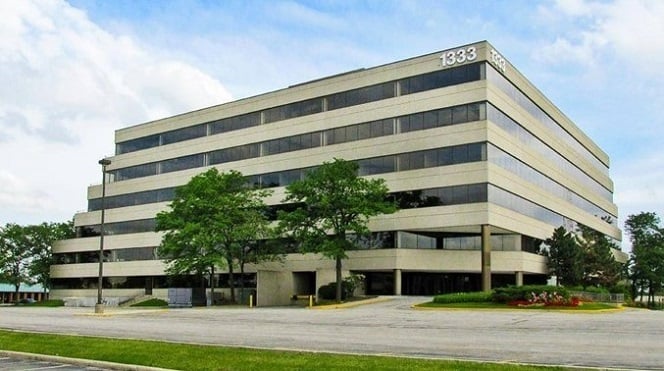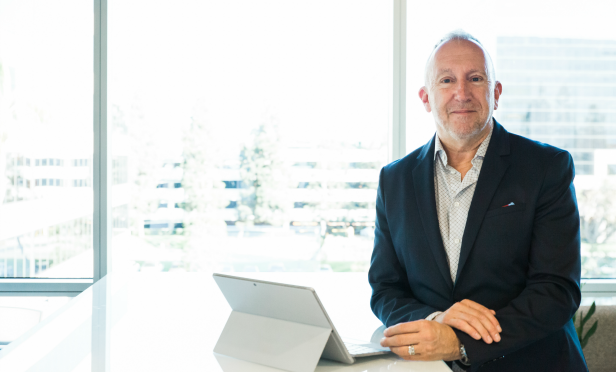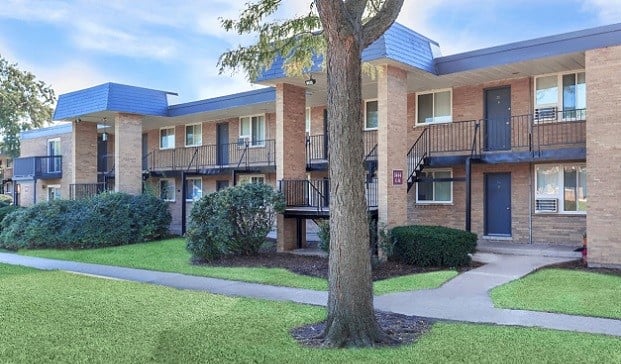
SOUTHFIELD, MI—Founded in 1976, Farbman Group manages more than 25 million square feet of office, retail, multifamily and industrial space throughout the Midwest. It recently entered the Milwaukee market by purchasing the Chase Tower for $30.5-million, making it just one of many investors that now sees great value in the region's secondary markets, especially the CBDs. GlobeSt.com recently spoke with the Southfield, MI-based firm's chief executive officer, Andy Farbman, about his company's recent transactions and the forces that will shape the regional office industry in this exclusive Q&A.
Q: What are some of the major trends you're seeing in the Midwest commercial real estate market that will have an impact across the commercial real estate landscape throughout 2017?
A: Debt markets are definitely off to a great start in 2017, with issuances for CMBS, life and alternative lenders all up in volume. Urbanity, density and modernity all are playing a huge role in attracting new projects. Every Midwest city from Detroit to Chicago to Milwaukee has lots of “cranes in the ground.”
Q: You mention Chicago, Detroit and Milwaukee. Is there something going on in those cities that is particularly appealing and contributing to the pace of construction?
A:The entire Midwest commercial real estate market is pretty hot right now. While those cities are obviously the headliners, I think the larger story is the growing popularity of activated downtown environments. As more and more people want to—and are starting to—live, work and play in the center of these dense urban areas, CBDs are heating up. More and more businesses are moving their offices to be in the center of it all.
Q: And developers are moving to take advantage of that “heat”?
A: If they're smart they are. Our own portfolio certainly reflects that. Farbman Group recently purchased the Chase Tower in Milwaukee at a relatively low price, giving us the financial flexibility to upgrade the lobby area and add new amenities to it to meet the emerging demands of an evolving consumer base.
Q: What specific factors are drawing this interest in CBDs?
A: It's increasingly evident that an educated millennial work force is calling the shots. There's been so much discussion about the impact of Millennials, but I think that's appropriate—this is an increasingly influential demographic, and their priorities and preferences are shaping a lot of decisions right now. So many of the trends we are seeing across the region and across the industry are influenced by this Millennial calculus.
Q: Talk a little more about those trends, if you don't mind. Presumably it extends beyond CBDs?
A: Absolutely. Millennials are, at least to some extent, driving things like the up-tick in suburban office product, changing tenant desires for what office space should look like, and trends such as shared workspaces and the resurgence of the live-work-play dynamic that has become such a priority for developers and municipalities alike. And of course the urban resurgence and the growing popularity of CBDs that we've been discussing. A great many companies are chasing the employees in these markets and these urban environments. In addition, multifamily developers are building new, more modern towers to attract Millennials and empty nester baby boomers.
Q: So the hospitality sector remains active?
A: It does. There are some questions within the industry about what the extent of this boom will look like, but there is just a ton of action in hospitality right now. Here again we see the drive to create something creative and deliver that experiential edge that Millennials are looking for. Take the Shinola Hotel project that just broke ground in Detroit, for example. It's an eight-floor, 130-room boutique hotel on Woodward Avenue. What's interesting is that the finished project will include 16,000 square feet of retail and dining space, as well as an integrated “alleyway” passage that connects the hotel to additional nearby retail and restaurants. And that's just one of a crop of boutique hotels that has been launched in Detroit recently.
Q: So hoteliers are taking advantage of historic buildings and urban opportunities in the same way that developers and investors are moving in office and multifamily?
A: Definitely. There's another Detroit project underway right now that illustrates that perfectly: The Element Detroit, a $32 million, 110-key extended-stay hotel in the historic Metropolitan Building. Here you have a 98,000-square-foot historic building, originally built in 1925, that has been vacant for literally decades. It's exciting stuff. And it isn't just Detroit. In Chicago there are new hotel concepts cropping up everywhere—particularly in The Loop and the West Loop. Again, the key here is the experience. Whether it's hospitality, office or multifamily, the drive to deliver that experience for retailers, residents, shoppers and guests is significant. The two main ways we are seeing that manifested are in the growing prevalence of historic renovations and unique spaces, and the increased integration of new technology in these properties.
Q: Speaking of technology, I know commercial real estate professionals are making greater use of tech not just as amenities, but as valuable professional tools—is that something you've seen more of lately?
A: No question about it. We rely on technology here at Farbman to what feels like a greater extent with each passing year. Historically, the real estate industry has been a little bit behind the technology curve, but it's fair to say that we are in the midst of a true tech boom right now. We use tools like drones to take aerial photos and video, smart lock technology to facilitate secure and convenient access to buildings, and apps like iTenant to share property information with tenants and prospects. Farbman has come to rely more and more on View The Space, a platform that allows tenants to evaluate properties, including detailed financial analyses, in real time and Landlord's to view leasing in real time. We also use FastOffice to create live space plans that integrate furniture and 3D renderings. Across the industry, we are seeing the growing popularity of tools like Buildout, which streamlines property marketing; Honest Buildings, which ensures competitive vendor bidding and consistent documentation; ProLease, tenant representative lease administration software; and Liquid Space, a space-sharing hub that allows unused or underutilized spaces to be rented out by the day or by the hour.
Q: Finally, what are your predictions for the Midwest Market—specifically CBDs for 2017?
A: I don't mean to be repetitive, but, for 2017 at least, I think it's more of the same. We are likely to see continued expansion in the urban Midwest centers. Really they are somewhat of a last frontier of urban centers that still have space to grow: infill projects will continue to add density and deliver hip new destinations squarely targeting those Millennials and empty nesters that are such a big part of this continuing Midwest urban renaissance.

SOUTHFIELD, MI—Founded in 1976, Farbman Group manages more than 25 million square feet of office, retail, multifamily and industrial space throughout the Midwest. It recently entered the Milwaukee market by purchasing the Chase Tower for $30.5-million, making it just one of many investors that now sees great value in the region's secondary markets, especially the CBDs. GlobeSt.com recently spoke with the Southfield, MI-based firm's chief executive officer, Andy Farbman, about his company's recent transactions and the forces that will shape the regional office industry in this exclusive Q&A.
Q: What are some of the major trends you're seeing in the Midwest commercial real estate market that will have an impact across the commercial real estate landscape throughout 2017?
A: Debt markets are definitely off to a great start in 2017, with issuances for CMBS, life and alternative lenders all up in volume. Urbanity, density and modernity all are playing a huge role in attracting new projects. Every Midwest city from Detroit to Chicago to Milwaukee has lots of “cranes in the ground.”
Q: You mention Chicago, Detroit and Milwaukee. Is there something going on in those cities that is particularly appealing and contributing to the pace of construction?
A:The entire Midwest commercial real estate market is pretty hot right now. While those cities are obviously the headliners, I think the larger story is the growing popularity of activated downtown environments. As more and more people want to—and are starting to—live, work and play in the center of these dense urban areas, CBDs are heating up. More and more businesses are moving their offices to be in the center of it all.
Q: And developers are moving to take advantage of that “heat”?
A: If they're smart they are. Our own portfolio certainly reflects that. Farbman Group recently purchased the Chase Tower in Milwaukee at a relatively low price, giving us the financial flexibility to upgrade the lobby area and add new amenities to it to meet the emerging demands of an evolving consumer base.
Q: What specific factors are drawing this interest in CBDs?
A: It's increasingly evident that an educated millennial work force is calling the shots. There's been so much discussion about the impact of Millennials, but I think that's appropriate—this is an increasingly influential demographic, and their priorities and preferences are shaping a lot of decisions right now. So many of the trends we are seeing across the region and across the industry are influenced by this Millennial calculus.
Q: Talk a little more about those trends, if you don't mind. Presumably it extends beyond CBDs?
A: Absolutely. Millennials are, at least to some extent, driving things like the up-tick in suburban office product, changing tenant desires for what office space should look like, and trends such as shared workspaces and the resurgence of the live-work-play dynamic that has become such a priority for developers and municipalities alike. And of course the urban resurgence and the growing popularity of CBDs that we've been discussing. A great many companies are chasing the employees in these markets and these urban environments. In addition, multifamily developers are building new, more modern towers to attract Millennials and empty nester baby boomers.
Q: So the hospitality sector remains active?
A: It does. There are some questions within the industry about what the extent of this boom will look like, but there is just a ton of action in hospitality right now. Here again we see the drive to create something creative and deliver that experiential edge that Millennials are looking for. Take the Shinola Hotel project that just broke ground in Detroit, for example. It's an eight-floor, 130-room boutique hotel on Woodward Avenue. What's interesting is that the finished project will include 16,000 square feet of retail and dining space, as well as an integrated “alleyway” passage that connects the hotel to additional nearby retail and restaurants. And that's just one of a crop of boutique hotels that has been launched in Detroit recently.
Q: So hoteliers are taking advantage of historic buildings and urban opportunities in the same way that developers and investors are moving in office and multifamily?
A: Definitely. There's another Detroit project underway right now that illustrates that perfectly: The Element Detroit, a $32 million, 110-key extended-stay hotel in the historic Metropolitan Building. Here you have a 98,000-square-foot historic building, originally built in 1925, that has been vacant for literally decades. It's exciting stuff. And it isn't just Detroit. In Chicago there are new hotel concepts cropping up everywhere—particularly in The Loop and the West Loop. Again, the key here is the experience. Whether it's hospitality, office or multifamily, the drive to deliver that experience for retailers, residents, shoppers and guests is significant. The two main ways we are seeing that manifested are in the growing prevalence of historic renovations and unique spaces, and the increased integration of new technology in these properties.
Q: Speaking of technology, I know commercial real estate professionals are making greater use of tech not just as amenities, but as valuable professional tools—is that something you've seen more of lately?
A: No question about it. We rely on technology here at Farbman to what feels like a greater extent with each passing year. Historically, the real estate industry has been a little bit behind the technology curve, but it's fair to say that we are in the midst of a true tech boom right now. We use tools like drones to take aerial photos and video, smart lock technology to facilitate secure and convenient access to buildings, and apps like iTenant to share property information with tenants and prospects. Farbman has come to rely more and more on View The Space, a platform that allows tenants to evaluate properties, including detailed financial analyses, in real time and Landlord's to view leasing in real time. We also use FastOffice to create live space plans that integrate furniture and 3D renderings. Across the industry, we are seeing the growing popularity of tools like Buildout, which streamlines property marketing; Honest Buildings, which ensures competitive vendor bidding and consistent documentation; ProLease, tenant representative lease administration software; and Liquid Space, a space-sharing hub that allows unused or underutilized spaces to be rented out by the day or by the hour.
Q: Finally, what are your predictions for the Midwest Market—specifically CBDs for 2017?
A: I don't mean to be repetitive, but, for 2017 at least, I think it's more of the same. We are likely to see continued expansion in the urban Midwest centers. Really they are somewhat of a last frontier of urban centers that still have space to grow: infill projects will continue to add density and deliver hip new destinations squarely targeting those Millennials and empty nesters that are such a big part of this continuing Midwest urban renaissance.
Want to continue reading?
Become a Free ALM Digital Reader.
Once you are an ALM Digital Member, you’ll receive:
- Breaking commercial real estate news and analysis, on-site and via our newsletters and custom alerts
- Educational webcasts, white papers, and ebooks from industry thought leaders
- Critical coverage of the property casualty insurance and financial advisory markets on our other ALM sites, PropertyCasualty360 and ThinkAdvisor
Already have an account? Sign In Now
*May exclude premium content© 2025 ALM Global, LLC, All Rights Reserved. Request academic re-use from www.copyright.com. All other uses, submit a request to [email protected]. For more information visit Asset & Logo Licensing.








